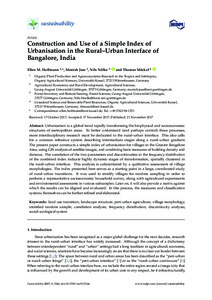Aufsatz
Artikel (Publikationen im Open Access gefördert durch die UB)

Construction and Use of a Simple Index of Urbanisation in the Rural–Urban Interface of Bangalore, India
Zusammenfassung
Urbanisation is a global trend rapidly transforming the biophysical and socioeconomic structures of metropolitan areas. To better understand (and perhaps control) these processes, more interdisciplinary research must be dedicated to the rural–urban interface. This also calls for a common reference system describing intermediate stages along a rural–urban gradient. The present paper constructs a simple index of urbanisation for villages in the Greater Bangalore Area, using GIS analysis of satellite images, and combining basic measures of building density and distance. The correlation of the two parameters and discontinuities in the frequency distribution of the combined index indicate highly dynamic stages of transformation, spatially clustered in the rural–urban interface. This analysis is substantiated by a qualitative assessment of village morphologies. The index presented here serves as a starting point in a large, coordinated study of rural–urban transitions. It was used to stratify villages for random sampling in order to perform a representative socioeconomic household survey, along with agricultural experiments and environmental assessments in various subsamples. Later on, it will also provide a matrix against which the results can be aligned and evaluated. In this process, the measures and classification systems themselves can be further refined and elaborated.
Zitierform
In: Sustainability. - Basel : MDPI, 2017, 9, 2146, 1-21Förderhinweis
Gefördert durch den Publikationsfonds der Universität KasselSammlung(en)
Publikationen (Fachgebiet Grünlandwissenschaft und Nachwachsende Rohstoffe)Artikel (Publikationen im Open Access gefördert durch die UB)
Zitieren
@article{urn:nbn:de:hebis:34-2018020554429,
author={Hoffmann, Ellen M. and Jose, Monish and Nölke, Nils and Möckel, Thomas},
title={Construction and Use of a Simple Index of Urbanisation in the Rural–Urban Interface of Bangalore, India},
year={2017}
}
0500 Oax 0501 Text $btxt$2rdacontent 0502 Computermedien $bc$2rdacarrier 1100 2017$n2017 1500 1/eng 2050 ##0##urn:nbn:de:hebis:34-2018020554429 3000 Hoffmann, Ellen M. 3010 Jose, Monish 3010 Nölke, Nils 3010 Möckel, Thomas 4000 Construction and Use of a Simple Index of Urbanisation in the Rural–Urban Interface of Bangalore, India / Hoffmann, Ellen M. 4030 4060 Online-Ressource 4085 ##0##=u http://nbn-resolving.de/urn:nbn:de:hebis:34-2018020554429=x R 4204 \$dAufsatz 4170 7136 ##0##urn:nbn:de:hebis:34-2018020554429
<resource xsi:schemaLocation="http://datacite.org/schema/kernel-2.2 http://schema.datacite.org/meta/kernel-2.2/metadata.xsd"> 2018-02-05T12:53:18Z 2018-02-05T12:53:18Z 2017-11-21 2071-1050 urn:nbn:de:hebis:34-2018020554429 http://hdl.handle.net/123456789/2018020554429 Gefördert durch den Publikationsfonds der Universität Kassel eng Urheberrechtlich geschützt https://rightsstatements.org/page/InC/1.0/ land use transition landscape structure peri-urban agriculture village morphology stratified random sample correlation analysis frequency distribution discontinuity analysis social–ecological system 630 Construction and Use of a Simple Index of Urbanisation in the Rural–Urban Interface of Bangalore, India Aufsatz Urbanisation is a global trend rapidly transforming the biophysical and socioeconomic structures of metropolitan areas. To better understand (and perhaps control) these processes, more interdisciplinary research must be dedicated to the rural–urban interface. This also calls for a common reference system describing intermediate stages along a rural–urban gradient. The present paper constructs a simple index of urbanisation for villages in the Greater Bangalore Area, using GIS analysis of satellite images, and combining basic measures of building density and distance. The correlation of the two parameters and discontinuities in the frequency distribution of the combined index indicate highly dynamic stages of transformation, spatially clustered in the rural–urban interface. This analysis is substantiated by a qualitative assessment of village morphologies. The index presented here serves as a starting point in a large, coordinated study of rural–urban transitions. It was used to stratify villages for random sampling in order to perform a representative socioeconomic household survey, along with agricultural experiments and environmental assessments in various subsamples. Later on, it will also provide a matrix against which the results can be aligned and evaluated. In this process, the measures and classification systems themselves can be further refined and elaborated. open access In: Sustainability. - Basel : MDPI, 2017, 9, 2146, 1-21 Hoffmann, Ellen M. Jose, Monish Nölke, Nils Möckel, Thomas doi:10.3390/su9112146 </resource>
Die folgenden Lizenzbestimmungen sind mit dieser Ressource verbunden:
Urheberrechtlich geschützt

